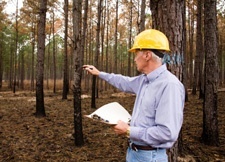FIRE PROTECTION ENGINEERING DEGREES AND CAREERS
What You'll Do

By Jennifer Wegerer
Fire protection engineering professionals use science and technology to research the causes of fires and determine fire protection methods. Among their many job duties, fire and safety engineers recommend or design fire detection materials or equipment that will help protect life and property against fire, explosion, and related hazards.
In order to carry out this role, fire protection engineers might perform several of the following different job tasks:
- Inspect buildings or building designs for potential fire protection problems.
- Advise architects and builders on fire codes and fire protection equipment.
- Create plans to prevent damage or destruction from fire, wind, and water.
- Manage the purchase, installation, and maintenance of fire protection systems.
- Test construction materials and consumer products for fire safety.
- Remain abreast of local safety regulations and recommend changes to authorities as necessary.
Job Opportunities
From fire departments and government agencies to research labs and forensic investigations, fire and safety engineers enjoy a wide range of career opportunities in diverse organizations. They work in hospitals, colleges, insurance companies and even the entertainment industry. Along with salaried positions, fire and safety engineers can go into private consulting. According to the U.S. Department of Labor, Employment and Training Administration (DOL), the top industries for fire protection engineering are manufacturing and construction.
The Future of Fire Protection Engineering
Clearly, fire protection engineering saves lives. But people who experience the stress that a fire inherently elicits can forget to trigger fire alarms, fail to follow escape routes or make other bad decisions that inadvertently endanger people's lives. To compensate for these reactions, fire and safety engineers have turned to technology, and the strides they have made are fascinating.
As an example, active monitoring systems on portable fire extinguishers can initiate a fire alarm signal or notify a building authority of the fire the moment someone lifts the extinguisher. These systems also incorporate obstruction detection technology, which senses whether something is blocking the fire extinguisher, as well as a pressure gauge containing an electrical output that signals when the pressure has fallen below safe operating levels.
Schools & Degrees
The Society of Fire Protection Engineers (FPE) indicates that students interested in fire protection science can take one of two paths: fire protection engineering or fire protection technology. Different colleges and universities offer bachelor's- and master's-level training in both arenas.
- Fire protection engineering focuses on developing theoretical and engineering skills in the analysis and design of fire protection equipment and materials
- The study of fire protection technology emphasizes the application, installation and operation of fire safety systems
Some schools might offer fire and safety engineering courses as electives that students can take as part of another engineering specialty, which can help build a foundation for an eventual master's degree. Whatever path a student chooses, earning a degree and gaining practical experience are the two key factors toward finding success and job opportunities as a fire and safety engineer.
Salaries
According to the U.S. Bureau of Labor Statistics' 2023 Occupational Employment Statistics, the median national annual salary for health and safety engineers is $103,690. Actual salaries may vary greatly based on specialization within the field, location, years of experience and a variety of other factors. National long-term projections of employment growth may not reflect local and/or short-term economic or job conditions, and do not guarantee actual job growth.
Did You Know?
Lightning causes approximately 17,400 fires each year in the U.S., two-thirds of which occur during June, July and August. While lightning fires result in a relatively small number of injuries and deaths, the dollar loss per fire is double that of all non-lightning fires in the country.
Engineering Degrees
- Bachelor's Degree
- Master's Degree
- Doctorate Degree
- Post-Doctorate Training
- Online Engineering Degrees
